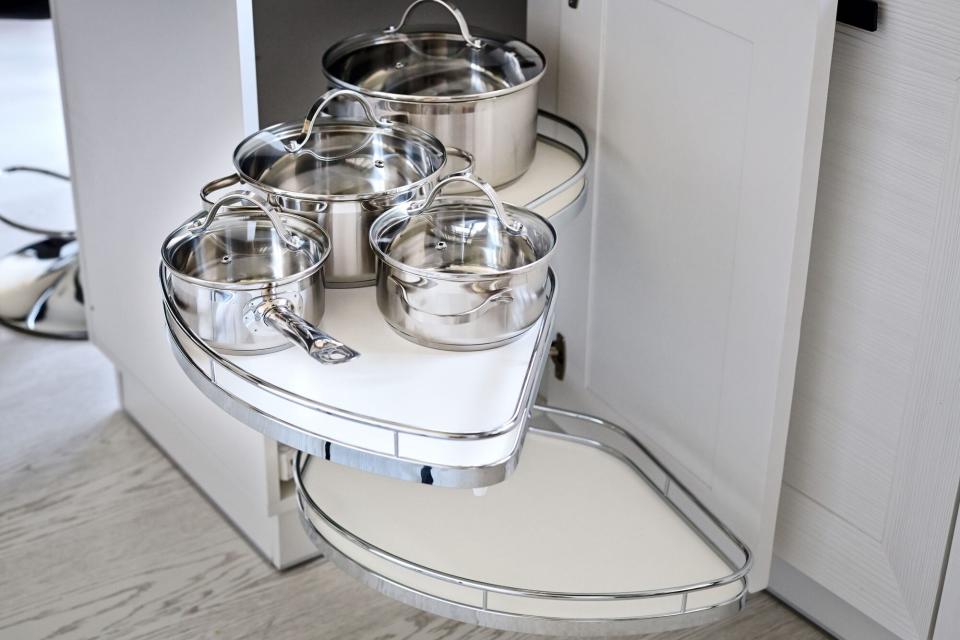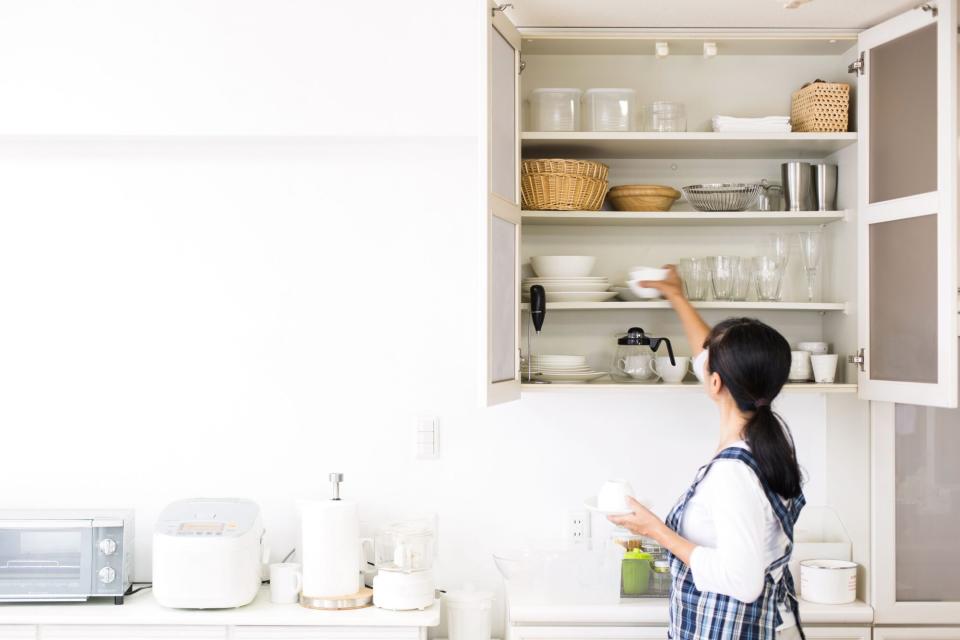How to Organize Your Kitchen Cabinets for Good

GETTY IMAGES
The kitchen truly is the center of your home—it's where you gather to make family meals or prepare for a dinner party. Since this space sees so much action, it's important that it is organized with efficiency and accessibility in mind. But when was the last time you took a peek inside your cabinets? No matter how hard you try, they inevitably become cluttered. Tidying them up, however, is a must if you want your kitchen to work as hard for you as you do in it.
To tackle your cramped, too-full kitchen cabinets, create a strategy before diving into the organization process. (This will prevent you from feeling overwhelmed by everything inside of them!) To help, here's how experts recommend organizing your kitchen cabinets with ease.
Related: These Are the 4 Most Popular Kitchen Cabinet Styles
When to Organize Your Kitchen Cabinets
Organizing your kitchen cabinets is a two-phase process, says Joanna Wirick, an organizing expert. "I would say organize once every once every couple of years. Tidying should happen every quarter," she says. The only reason to up that frequency? A major life change, including moving, moving in with someone (when you're likely to find yourself with a lot of duplicates!), or welcoming a little one, Wirick says.
The ultimate goal is to thoroughly organize once and allow your system to simply exist so it functions for your family. Tidying every quarter allows for those "maintenance checks," says Wirick. That's when you can assess items for wear and tear, missing lids, and more.
How to Organize Kitchen Cabinets
Before you dig into the organization process, think about your overall strategy, says Malaika Lubega, a professional organizer, interior decorator, and the owner of Huza Home Concepts. "The best way to organize your kitchen items and keep them organized is by categorizing, keeping like items together, and by using proper organizing products," she says.
1. Take Everything Out
In order to know what you can and should part with, you have to figure out what you already own, says Jamie Hord, the founder of professional home organizing company Horderly. "Always make sure you start with a full pull-out of every single item in your kitchen," she says.

GETTY IMAGES
2. Sort Your Items
You've removed everything from your cabinets—don't panic! It may look like a lot, but you have a strategy in place to make sure everything finds its home. The next step is to sort your items into categories. Put your pots and pans, flatware, bar tools, and everything in between into their own sections.
3. Decide What You Want to Keep
If you haven't combed through your cabinets in a while, chances are you'll have some duplicate items and things you haven't used in a while. Wirick's advice is to have no more than two of something, as even experienced cooks just have one of each as their go-to, along with multi-use pieces of cookware. "I would say invest in something that's higher quality and have one of it instead of three or four," she says.
Keep, Toss, or Donate
After you identify what you need, determine what you're ready to let go of. "Once [everything is] pulled out and sorted, edit those items to determine what you'd like to keep, toss, or donate," says Hord.
4. Determine Frequency of Use
Once you know what you want to keep, figure out which items you use daily and weekly, as well as the items you only use a few times a year. This will help you determine what can be stored in harder-to-reach areas (like your holiday serveware) and what you want to keep close by (like everyday glassware).
Think about the structure of your cabinets, too. "Our kitchen has a lot of cabinets, but not all of them are conveniently placed," says Eunice Byun, co-founder of online kitchenware company Material Kitchen. "Some are super high up and require a step stool, so we put things we don't need often [there]."

GETTY IMAGES
5. Put Away Kitchenware Where It Makes Sense
After determining what kitchenware should go into your prime real estate cabinets and which can go in lesser-used spots, it's time for the best part—putting your items away. It helps to group like things together (pans in one drawer, pots in another) and to think about how you move through your kitchen.
Always organize based on where you will need to access your items. "Things we need for prep [should be] placed closer to our countertop space, where we do a lot of the chopping—which happens to be near our sink, which makes it easier for washing and chopping seamlessly," says Byun.
Don't Overlook Your Drawers
Yes, it's important that your system makes sense, but don't shy away from getting creative when it comes to storing your items—especially if your kitchen has a unique layout. "Does your kitchen have all drawers and one cabinet? Perhaps you could put plates and bowls in a drawer instead of a cabinet," Hord says.
6. Label
Forgetting where you've stored certain cookware and serveware is half the reason why you're re-organizing to begin with. Prevent this from happening again by creating labels for each drawer and cabinet. "Once you have proper placement of everything, purchase products that can help in your organization, and most importantly, label," Hord says. "You can label the inside of the cabinet shelves, drawers, or any bins you use for containment with bin clip labels."

